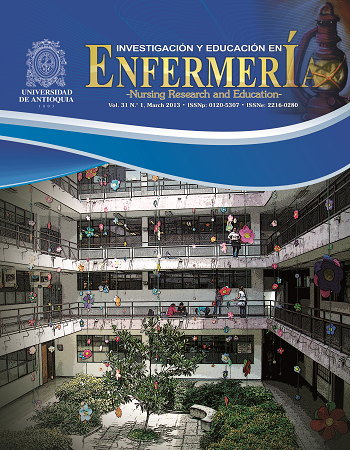Characteristics of users of the Birth Control program.
DOI:
https://doi.org/10.17533/udea.iee.11485Keywords:
Family planning (public health); sexual and reproductive health; contraception; health services.Abstract
Objective. This study sought to characterize the use of Birth Control methods by women users of Healthcare Service Provider Institutions in Colombia, who were included in the National Health Survey -2007 NHS.
Methodology. Ours was a descriptive study, which performed secondary analysis of the data from a subsample of 2033 women from the outpatient service of the Birth Control (BC) program in the Healthcare Service Provider Institutions (IPS, for the term in Spanish) included in the 2007 National Health Survey (NHS).
Results. The BC contraception methods most used by the women surveyed were: hormonal (60%), barrier (22%), and female sterilization (11%). A direct relationship was observed between educational level and the autonomy to select the BC method. A total of 11% of the users did not receive information on all the BC methods from their treating physician. Some 98% of the women surveyed manifested having understood the information provided on the use of the BC method selected. Nine of every 10 women exercised autonomy upon selecting a BC method.
Conclusion. The hormonal methods of Birth Control were the most used by the women surveyed. The participants showed high autonomy to choose the BC method.
Downloads
References
(1) Butz W. El doble cisma: Los implosionistas y explosionistas ponen en peligro los avances logrados desde la conferencia de El Cairo. [Internet].Washington: Population Reference Bureau; 2004. [cited 2011 Jun 21]. Available from: http://www.prb.org/SpanishContent/Articles/2004/ElDobleCisma.aspx
(2) Population Reference Bureau. Cuadro de la población mundial 2009. [internet]. Washington: Population Reference Bureau; 2009. [cited 2011 Jun 25]. Available from: http://www.prb.org/pdf09/wpds09_sp.pdf
(3) Profamilia. Salud Sexual y Reproductiva en Colombia. Encuesta Nacional de Demografía y Salud, 2000 [Internet]. Bogotá: Profamilia; 2003. [cited 2011 Nov 25]. Available from: http://www.encolombia.com/salud/saludsex-portada.htm
(4) Ojeda G, Ordóñez M, Ochoa LF. Salud sexual y reproductiva en Colombia: Encuesta Nacional de Demografía y Salud, Colombia 2005. Bogotá: Asociación Pro bienestar de la Familia Colombiana y PROFAMILIA; 2005.
(5) UNFPA. Salud Reproductiva. Perú: Prevalencia de uso de métodos anticonceptivos, en mujeres unidas, de 15 a 49 años, según área de residencia (1991, 1996, 2000). [Internet]. San Isidro: Fondo de Población de las Naciones Unidas. [cited 2011 Nov 24]. Available from: http://www.unfpa.org.pe/infosd/salud_reproductiva/salud_rep_02.htm
(6) Godínez Leal L. México: Cifras evidencian atropello a derechos sexuales y reproductivos de las mexicanas [Internet]. [cited 2011 Nov 24]. Available from: http://www.argenpress.info/2009/06/mexico-cifras-evidencian-atropello.html
(7) FESAL. Planificación familiar. Conocimiento de métodos anticonceptivos [Internet]. San Salvador: FESAL; 2008. [cited 2009 Nov 24]. Available from: http://www.fesal.org.sv/2008/informe/resumido/06-PlanifiicacionFamiliar.htm
(8) PROFAMILIA. Tendencias en la dinámica anticonceptiva en Colombia, 1990 - 2005 [Internet]. Bogotá: PROFAMILIA; 2005. [cited 2009 Nov 24]. Available from: http://www.profamilia.org.co/encuestas/01encuestas/profundidad/tendencias/dinamica.pdf
(9) Sánchez Torres F. Historia de la Ginecobstetricia en Colombia [Internet]. [cited 2009 Nov 14]. Available from: http://www.encolombia.com/contenido_ginecobstetricia.htm
(10) Eraso MP. La medicina en Colombia, una reseña histórica [Internet]. Aldo Campana; 2008. [cited 2009 Nov 1]. Available from:http://www.gfmer.ch/Colombia_Pilar/INDICE.htm
(11) País pionero en américa latina en la oferta de anticonceptivos modernos. Terra Networks Chile. (2008 Mar 05; Sexualidad) [Internet]. [cited 2009 Nov 25]. Available from: http://noticiascl.terra.cl/salud/interna/0,,OI2662510-EI5424,00.html
(12) Aramburu CE. Fecundidad y Planificación Familiar: Comparando las ENDES 2000 y 2004. [Internet]. [cited 2009 Oct 2]. Available from: http://www.gestiopolis.com/canales5/eco/consorcio/eys56/archivos/56-fecundidad-y-planificacion-familiar-en-el-peru.pdf
(13) Secretaria de Salud, centro Regional de investigaciones Multidisciplinarias. Encuesta nacional de salud reproductiva 2003, Tabulados Básicos. México: Universidad Autónoma de México; 2003.
Published
How to Cite
Issue
Section
License
Derechos de propiedad / Direitos de Propriedade
English: If the article is accepted for publication, all copyright will be of exclusive property of Investigación y Educación en Enfermería. The text and the graphics included in the publication are exclusive responsibility of the authors and not necessarily reflect the thought of the Editorial Committee.
Español: Si el artículo es aprobado para publicación, todos los derechos son de propiedad de Investigación y Educación en Enfermería. El texto y las gráficas incluidas en la publicación son de exclusiva responsabilidad de los autores y no necesariamente refleja el pensamiento del Comité Editorial.
Português: Se o artigo for aceito para publicação, todos os direitos autorais serão de propriedade exclusiva de Investigación y Educación en Enfermería. O texto e os gráficos incluídos na publicação são de responsabilidade exclusiva dos autores e não refletem necessariamente o pensamento do Comitê Editorial.















